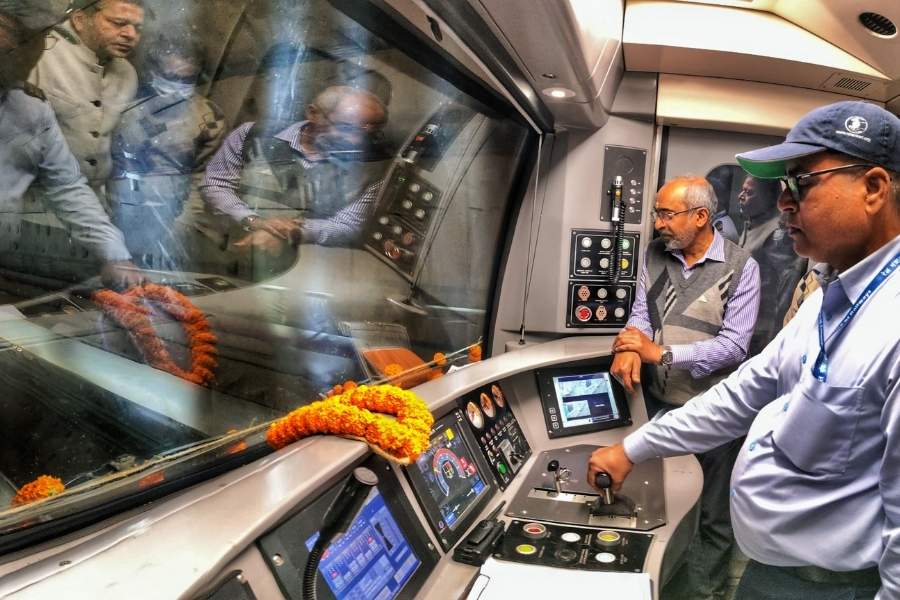 Wednesday, 22 January 2025
Wednesday, 22 January 2025
 Wednesday, 22 January 2025
Wednesday, 22 January 2025
The keys to a locked chamber filled with treasure believed to be guarded by serpents in a 12th century temple go missing. Duplicate keys are found, they don’t work. The locks to the chamber – which according to lore contains a hidden compartment inside – are broken open. What happens next?
The story of the Ratna Bhandar in the Jagannath Temple in Puri can be fodder for a Dan Brown novel. Or a season of Money Heist.
The Jagannath Temple or Sri Mandir near the Bay of Bengal in Puri, built during the reign of King Anantavarman Chodaganga Deva, had long barred outsiders from scrutinising the Bhitara Bhandar – inner sanctum – of the Ratna Bhandar or treasury room of the temple.
The Ratna Bhandar is a treasure trove of gold, diamonds, pearls and coral ornaments presented by devotees from across the world.
Sujata Rakshit, professor of Ancient Indian History Culture & Archaeology at Visva-Bharati University, Bengal, said that the Gajapati ruler sealed the Ratna Bhandar following the 1952 Jagannath Temple Act.
A detailed inventory of the Ratna Bhandar was published in the 1967 Odisha Gazette, listing 837 valuable items, Rakshit told The Telegraph Online.
She also mentioned that the inner chamber, or Bhitar Bhandar, has not been accessed frequently over the years due to myths suggesting that serpents guard the treasures.
On July 14 this year, the Puri temple’s Ratna Bhandar was opened after 46 years. There had been reports of hissing sounds from inside, so along with an 11-member government appointed panel there was a snake-catching team at hand. Its services were not required.
Delving into the historical record of the Ratna Bhandar is rather like deciphering a treasure map. History has it that in 1805, Charles Gomes, the then collector of Puri, meticulously documented the Bhitar Bhandar or inner chamber's treasures, uncovering ancient gold coins and valuable items.
An inscription on the Digvijay Dwar of the Jagannath Temple reveals that in 1466, Gajapati Kapilendra Dev donated a massive amount of gold, jewelled ornaments, and utensils to Lord Jagannath.
Many of these offerings were still in use by 1893, as noted by historian R.D. Banerjee in his ‘History of Orissa’.
In 1926, Gajapati Ramachandra Dev IV assumed the role of superintendent, issuing meticulous receipts for the jewellery and cash stored in the Ratna Bhandar. These original lists, along with his acknowledgements, are housed in the Puri Collectorate Record Room under double lock, bearing the signature of Dayanidhi Das, the then collector of Puri.
Cut to the present, and there are political overtones to the present story playing out over the 12th century temple.
Under chief minister Naveen Patnaik's BJD government, the Ratna Bhandar had remained largely sealed, which had led to public interest litigation regarding the stability and safety of the structure.
In February this year, acting on a Orissa High Court order after concerns from many quarters including the Archaelogical Survey of India, Patnaik formed a 12-member committee under the chairmanship of former Supreme Court judge Arijit Pasayat to supervise the preparation of the inventory of the jewels and valuables in the Ratna Bhandar.
Prime Minister Narendra Modi, during an election-campaign event in Odisha on May 11 this year, had targeted the Patnaik-led Odisha state government over the Ratna Bhandar.
The disappearance of the original keys to the Ratna Bhandar was a serious matter, Modi had said, adding that the presence of duplicate keys was even more worrisome. Were the duplicate keys misused to the pilfer the gods’ jewellery, he had asked.
In the Assembly election this year, Patnaik’s government fell. The new BJP chief minister, Mohan Charan Majhi, assured that the Ratna Bhandar would be opened for a full inventory. He set up a new 11-member panel led by Justice Biswanath Rath.
When asked whether the inner chamber of the Ratna Bhandar has a hidden tunnel or other secret chambers, Justice Rath was quoted by PTI as having told reporters: “I appeal to the media not to spread rumours. We have not seen any such things.”
As the inner chamber hadn't been opened for decades, a government-approved SOP was prepared to break the lock if necessary.
"The Ratna Bhandar is essentially like a state treasury with economic value, making it a target for attacks," Kanad Sinha, scholar at Sanskrit College and University, Calcutta, told The Telegraph Online.
He emphasised the need to protect its material value and noted that India has a history of temples being targeted, attacked and their treasures damaged or demolished. Religious places such as Buddhist Stupas, Shaktipeeths, and the Tirupati temple have also faced such threats.
While many religious shrines have such kinds of treasure chambers, Puri's Ratna Bhandar is even more mysterious because of its long-standing mythology and the tight security around it, Sinha added.
Odisha Congress spokesperson Biswaranjan Mohanty highlighted some of the unanswered questions. "Where are the original keys of Ratna Bhandar? The people are eagerly waiting to know about the original keys. So, the government should present a clear picture before the public," Mohanty told PTI.
The full picture will emerge post-inventory completion, but there are still shouts and murmurs that valuables in the Ratna Bhandar may have been tampered with.
Last week, Jagdish Mohanty, one of the 11 members of the panel led by Justice Rath, told reporters that “there was a criminal intention and motive to syphon off the valuables,” according to a report in The Times of India. The duplicate key was a hoax and theft attempt cannot be ruled out, he added.
“Jagannath Dev is more than a deity, he is an emotion for the vast bhakta brinda [devotees],” Indologist and priest Nandini Bhowmik told The Telegraph Online. “The ongoing political games must stop. Rumours are impacting the sentiments of the devotees and must be addressed promptly to preserve their faith.”.







